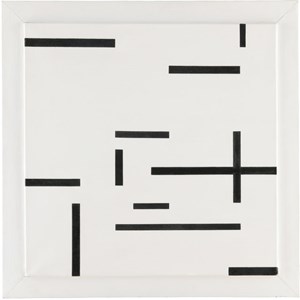
The Rijksmuseum has acquired three works by Marlow Moss: the 1948 painting White and Black (No 27) and two untitled drawings made around 1940 and 1957 respectively. Moss played an important role in the development of abstract art in Europe in the beginning of the 20th century.
This acquisition was made possible with the financial support of Pon and the Rijksmuseum Fonds: the Irma Theodora Fonds, the ‘Vrouwen van het Rijksmuseum’ Fonds (‘Women of the Rijksmuseum’ Fund), and a private benefactor.
In 1932 Marlow Moss (London, 1889-1958) joined Abstraction-Création, an international association of artists that included Georges Vantongerloo, Auguste Herbin and Theo van Doesburg. The aim of Moss and the group was to foster the development of abstract art and increase its prominence in Europe. Moss worked as an artist in Paris and Normandy, Cornwall in England, and the Dutch village of Biggekerke. As well as drawing inspiration from the De Stijl art movement, Moss explored musical composition, choreography and mathematics.
Moss was committed to liberating perceptions of art: ‘I don't see form. I only see space, movement and light.’ The pursuit of ever-shifting structures also manifested itself in the personal life of the artist: Moss regarded identity as a fluid concept and in the 1920s adopted a gender-neutral first name. Looking back on this period in 1955, Moss wrote: ‘I destroyed my old personality and created a new one. Identity, like everything else, isn’t fixed but rather something one constructs for oneself on a day-to-day basis. Art is as Life, forever in the state of Becoming.’
Piet Mondrian and Marlow Moss admired one another’s artistic practice. They corresponded regularly, frequently engaging in discussion and inspiring each other. In 1940, Mondrian encouraged Moss to leave England with him and move to New York. ‘You can either come with me or you can stay in England and be doomed to obscurity and failure,’ he wrote. Moss ignored his warning and remained in Lamorna in Cornwall, continuing to work and live with Netty Nijhoff.
White and Black (No 27) was owned for many decades by Nijhoff. The complete absence of colour distinguishes it from many other works in the artist's oeuvre. This painting on a square canvas comprises a rhythmic arrangement of seemingly vertical and horizontal black lines. Moss encouraged viewers to see such lines as a form of notation for a musical composition. This painting is one of the only two known works from the 1940s in exclusively black and white – the other is held by the Museum of Modern Art in New York.
Moss worked systematically, making numerous preparatory studies for paintings and sculptures. The drawings acquired by the Rijksmuseum offer insights into Moss’ creative process. The c. 1957 drawing, a sketch of the rear of a sculpture, testifies to the precision of Moss’s calculations. The c. 1940 drawing is a standalone work comprising three coloured circles apparently moving independently of one another – this is a motif that recurs in several sculptures by Moss.
Image : Marlow Moss, White and Black 27

ArtDependence Magazine is an international magazine covering all spheres of contemporary art, as well as modern and classical art.
ArtDependence features the latest art news, highlighting interviews with today’s most influential artists, galleries, curators, collectors, fair directors and individuals at the axis of the arts.
The magazine also covers series of articles and reviews on critical art events, new publications and other foremost happenings in the art world.
If you would like to submit events or editorial content to ArtDependence Magazine, please feel free to reach the magazine via the contact page.